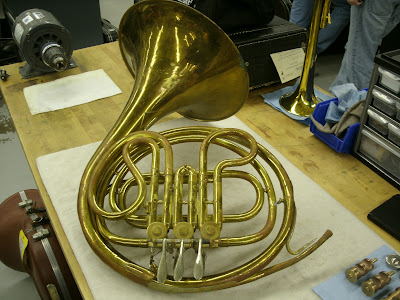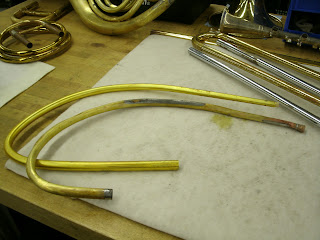This is a conversion suggested to me by Greg, my instructor. The idea is to take a single horn with worn out valves and to remove them, resulting in a natural horn.

The Cor Solo is a natural horn that has crooks which are added at the main tuning slide section as opposed to terminal crooks that form different mouthpipes. Here you can see the horn before removing the valves. It is a Regent, made by the Ohio Band Instrument Co. in Cleveland, Ohio. The next picture shows a close shot of the bell.
Once the horn is clean, the first step is to remove the entire valve section. I removed the ferrule on either side of the knuckles and also disconnected the braces that were attached to the valve section.

Next I made new ferrules that matched the style I wanted and used them to connect the new tubing to the old. In this picture you can also see that I have removed the guard plates as they would not have been originally used.

This photo shows the new braces and the removal of the older ones. Next I intend to replace the mouthpipe and to also fashion some tuning slides. Much more to come!
In the next three photographs it is possible to see that the lacquer finish has been stripped and the new mouthpipe has been installed. The fisrt picture shows the mouthpipe as I received it. Then picture number two shows the mouthpipe after bending, with the following picture showing the new mouthpipe installed.
It was necessary to replace the main tuning slide because the original had been missing when I received the horn. I could not find a replacement with the correct span but this was not an issue because of the replacement mouthpipe. I simply aligned the new mouthpipe with the replacement slide before soldering and now the two match perfectly. The next step will be to taper the mouthpipe to accept the mouth piece and to rebuild an Eb tuning slide to match the new span of this horn.







